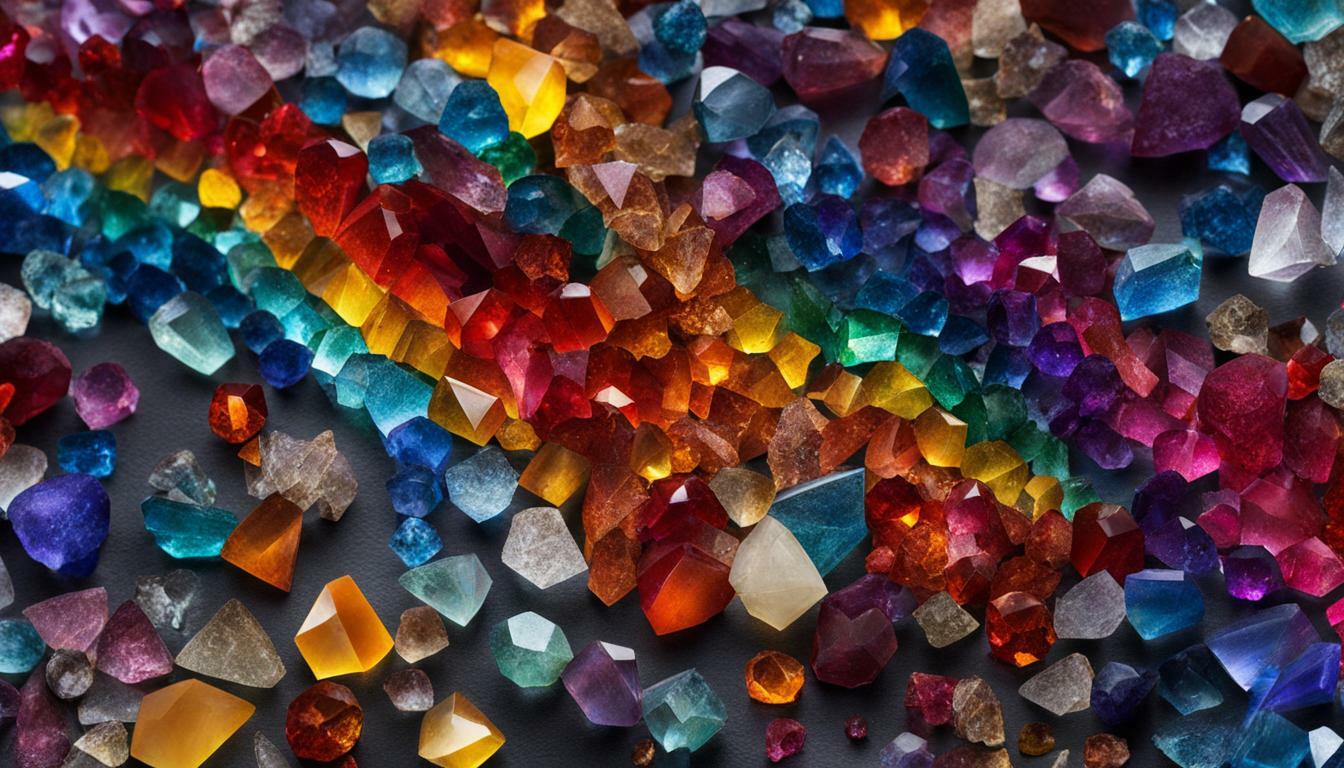Crystals come in a wide range of varieties and species, making the world of gemstones incredibly diverse. From popular gemstones like Ametrine and Aquamarine to lesser-known varieties such as Ancestralite and Auralite 23, the possibilities seem endless. If you’re curious about the different crystal types, crystal classification, crystal varieties, and crystal species, you’ve come to the right place. In this article, we will explore the vast array of crystals and delve into the question of how many different types there are.
Key Takeaways:
- Crystals come in a wide range of varieties and species.
- The world of gemstones is incredibly diverse.
- There are numerous examples of crystal types, including Ametrine, Ancestralite, Angelite, and Apache Tears.
- A comprehensive A-Z guide of crystals lists nearly 200 different types.
- Gems can be categorized based on their crystal systems, including cubic, tetragonal, hexagonal, trigonal, orthorhombic, monoclinic, and triclinic.
Understanding Crystal Types and Varieties
Crystals can be classified into various types and categories based on their physical and chemical composition. The world of crystals is incredibly diverse, with a wide range of gemstones and unique variations to explore. Whether you are a crystal enthusiast or simply fascinated by their beauty, understanding different crystal types and varieties can deepen your appreciation for these natural wonders.
One way to explore the diversity of crystals is through examples of different types. Some popular crystal types include Ametrine, Ancestralite, Angelite, Apache Tears, Blue Apatite, Green Apatite, Apophyllite, and Aquamarine, just to name a few. These crystals come in a variety of colors, shapes, and sizes, each with its own distinct properties and energetic qualities.
If you’re looking for a comprehensive guide to crystals, you’ll find a wealth of information in a crystal A-Z guide. One such source provides an extensive list of nearly 200 crystal types, covering everything from well-known gemstones to lesser-known varieties. Exploring this guide can be an exciting journey, introducing you to crystals you may have never encountered before.
In addition to exploring crystal types, understanding crystal variations is also important. Crystals can vary in terms of their color, transparency, size, and even the presence of specific mineral inclusions. These variations contribute to the uniqueness of each crystal, making them not only aesthetically pleasing but also intriguing from a scientific perspective.
Crystal Types and Their Classification
Crystal classification systems help organize crystals into different categories based on their crystal systems. The crystal systems categorize crystals into seven main groups: cubic, tetragonal, hexagonal, trigonal, orthorhombic, monoclinic, and triclinic. Each crystal system has its own characteristic geometric shapes and symmetry patterns. Understanding crystal classification can provide insights into the formation and structure of crystals.
| Crystal System | Examples |
|---|---|
| Cubic | Pyrite, Garnet |
| Tetragonal | Zircon, Rutile |
| Hexagonal | Quartz, Beryl |
| Trigonal | Amethyst, Rhodochrosite |
| Orthorhombic | Topaz, Sulfur |
| Monoclinic | Malachite, Amazonite |
| Triclinic | Moonstone, Labradorite |
Crystals are not only beautiful, but they also hold energetic and metaphysical properties that can benefit individuals in various ways. Whether you’re drawn to the vibrant colors of gemstones or the intricate formations of quartz crystals, the world of crystal types and varieties is a fascinating realm waiting to be explored.
Crystal Classification Systems
Crystals can be classified into different families and systems based on their internal structure and symmetry. This classification allows us to categorize crystals according to their unique properties and characteristics. One common method of classifying crystals is through crystal systems, which are based on the symmetry of their internal arrangement of atoms.
There are seven main crystal systems: cubic, tetragonal, hexagonal, trigonal, orthorhombic, monoclinic, and triclinic. Each system has distinct characteristics that define the shape and symmetry of the crystals within it. For example, cubic crystals have equal dimensions and are characterized by their sharp edges and symmetrical faces.
Another method of classification is based on crystal families. Crystal families group together crystals with similar internal structures but different external appearances. Some common crystal families include quartz, feldspar, and garnet. These families allow us to identify crystals that may have different colors or shapes but share the same fundamental atomic arrangement.
Cubic Crystal System
| Examples | Properties | Color |
|---|---|---|
| Diamond | Hardness: 10 | Colorless |
| Pyrite | Hardness: 6-6.5 | Pale brass-yellow |
| Garnet | Hardness: 6.5-7.5 | Red, green, yellow |
Crystal classification systems provide a useful framework for understanding the diverse world of crystals. By studying their internal structures and symmetries, we can gain insights into their properties and how they form. Whether you’re a crystal enthusiast or a scientist, exploring the different families and systems of crystals can deepen your appreciation for their beauty and complexity.
Examples of Crystal Types
Some examples of crystal types include Ametrine, Ancestralite, Angelite, Apache Tears, Blue Apatite, Green Apatite, Apophyllite, Aquamarine, Aragonite, Arfvedsonite, Astrophyllite, Atlantisite, Auralite 23, Blue Aventurine, Green Aventurine, Red Aventurine, White Aventurine, and many more. Each crystal possesses its own unique properties and characteristics, making them distinct from one another.
For those interested in exploring the diverse world of crystals, a comprehensive A-Z guide can be a valuable resource. This guide provides detailed information on nearly 200 different types of crystals, including their origins, metaphysical properties, and recommended uses.
A Comprehensive A-Z Guide of Crystals
| Crystal Type | Origin | Metaphysical Properties | Recommended Uses |
|---|---|---|---|
| Ametrine | Bolivia, Brazil | Promotes balance, harmony, and spiritual growth | Enhances clarity, focus, and creativity |
| Ancestralite | United States | Connects with ancestral wisdom and healing | Aids in ancestral communication and past life exploration |
| Angelite | Peru | Brings in calm, serenity, and angelic connection | Supports communication and healing through angelic guidance |
| Apache Tears | United States | Provides protection, grounding, and emotional healing | Aids in emotional release and transformation |
| Blue Apatite | United States, Brazil, Mexico | Enhances intuition, intellect, and spiritual development | Supports self-expression, manifestation, and personal growth |
| Green Apatite | Brazil | Stimulates the heart chakra and promotes healing | Aids in emotional balance and physical rejuvenation |
These are just a few examples of the diverse crystals available. Each crystal type has its own unique energy and purpose, making them valuable tools for personal growth, healing, and spiritual exploration. Whether you are drawn to the beauty of Ametrine or the calming energy of Angelite, there is a crystal out there that resonates with you and your intentions.
Remember, when working with crystals, it’s important to cleanse and charge them regularly to ensure they maintain their optimal energy. Whether you choose to wear them as jewelry, place them in your home or workspace, or meditate with them, crystals can bring beauty, balance, and positive energy into your life.
A Comprehensive A-Z Guide of Crystals
If you’re interested in a specific crystal, this guide will provide you with a wealth of information on a wide range of crystals. Whether you’re a crystal enthusiast or just starting your journey into the fascinating world of crystals, this guide is designed to help you explore and understand the diverse types and variations available.
From Ametrine to White Aventurine, there are countless crystal types to discover. Each crystal has its own unique properties and characteristics, making them perfect for different purposes and intentions. For example, Blue Apatite is known to enhance communication and self-expression, while Apache Tears are believed to assist in healing emotional wounds.
For those wanting an in-depth exploration of crystal types, a comprehensive A-Z guide is available. This guide lists nearly 200 different crystals, covering a wide range of gemstones and lesser-known varieties. It provides information on their properties, metaphysical attributes, and recommended uses.
| Crystal Type | Properties | Metaphysical Attributes | Recommended Uses |
|---|---|---|---|
| Ametrine | Combination of amethyst and citrine | Enhances mental clarity and creativity | Focus and manifestation |
| Angelite | Soft blue stone with a calming energy | Facilitates angelic communication and spiritual growth | Meditation and connecting with higher realms |
| Apache Tears | Black obsidian nodules | Supports emotional healing and protection | Grief release and grounding |
If you’re interested in the scientific classification of crystals, they can be categorized based on their crystal systems, such as cubic, tetragonal, hexagonal, trigonal, orthorhombic, monoclinic, and triclinic. This categorization helps understand their internal structure and symmetry.
Whether you’re seeking a crystal for healing, meditation, or simply for their beauty, this comprehensive guide will assist you in discovering the perfect crystal for your needs. Explore the vast world of crystals and let their incredible energy and natural beauty enrich your life.
Crystals and Their Crystal Systems
Crystal systems help classify crystals based on their symmetry and arrangement of atoms. This classification is essential for understanding the unique properties and characteristics of different crystal types. The arrangement of atoms within a crystal determines its external shape, internal structure, and overall behavior.
There are seven main crystal systems: cubic, tetragonal, hexagonal, trigonal, orthorhombic, monoclinic, and triclinic. Each system has its distinctive characteristics, which contribute to the crystal’s overall symmetry.
The Seven Crystal Systems:
| Crystal System | Key Features | Examples |
|---|---|---|
| Cubic | Equal dimensions in all directions | Diamond, Pyrite, Fluorite |
| Tetragonal | Two dimensions are equal, the third is different | Zircon, Rutile, Staurolite |
| Hexagonal | Six-sided prism shape | Amethyst, Beryl, Quartz |
| Trigonal | Threefold symmetry | Calcite, Tourmaline, Agate |
| Orthorhombic | Three unequal axes at right angles | Topaz, Sphalerite, Stibnite |
| Monoclinic | Three unequal axes, one oblique angle | Amazonite, Celestite, Gypsum |
| Triclinic | No equal axes, all oblique angles | Labradorite, Kyanite, Moonstone |
By identifying the crystal system of a particular crystal, we gain insights into its unique properties, including its symmetry, hardness, cleavage, and optical characteristics. This knowledge not only enhances our understanding of crystals but also aids in their identification and use in various fields, such as jewelry making, energy healing, and scientific research.
Whether you’re fascinated by the dazzling brilliance of a diamond or the vibrant hues of an amethyst, exploring the diverse world of crystals is a captivating journey. Each crystal type holds its allure and significance, and understanding their crystal systems allows us to appreciate their beauty and tap into their energy and metaphysical properties. So, go ahead and explore the magnificent realm of crystals and unlock the secrets they hold.
Conclusion
Crystals are a mesmerizing part of the natural world, with countless types and variations that captivate our imagination and beauty. From the enchanting Ametrine to the calming Angelite, each crystal possesses its own unique energy and properties. Exploring the diverse world of crystals is like embarking on a magical journey, where every specimen unveils a new story waiting to be discovered.
If you’re eager to dive deeper into the realm of crystals, a comprehensive A-Z guide is available, listing nearly 200 different types. This guide serves as a valuable resource for both beginners and seasoned crystal enthusiasts, offering insights into the characteristics and metaphysical properties of each crystal.
Furthermore, crystals can also be classified based on their crystal systems, which include cubic, tetragonal, hexagonal, trigonal, orthorhombic, monoclinic, and triclinic. These classification systems provide a framework for understanding the structural arrangement of crystals and their distinct geometric properties. Learning about crystal systems adds another layer of appreciation for the intricate beauty and complexity of these natural wonders.
In conclusion, the world of crystals is vast and awe-inspiring, with an abundance of types, variations, and classifications to explore. Whether you’re drawn to the vibrant hues of Aventurine or the delicate sparkle of Aquamarine, there is a crystal out there to resonate with your energy and enhance your well-being. So, take a moment to connect with the enchanting world of crystals and experience the magic they have to offer.
Are All Types of Crystals Accounted for in the Total Number of Crystals in the World?
The number of crystals worldwide is difficult to determine definitively, as new crystal types continue to be discovered. Despite ongoing efforts to catalog and identify crystals, it is possible that some types remain undiscovered or unaccounted for. With the vast diversity of minerals and geological formations, it is an exciting prospect to think that there may still be unknown crystals waiting to be found.
If you’re interested in the scientific classification of crystals, they can be categorized based on their crystal systems, such as cubic, tetragonal, hexagonal, trigonal, orthorhombic, monoclinic, and triclinic. This categorization helps understand their internal structure and symmetry.
Whether you’re seeking a crystal for healing, meditation, or simply for their beauty, this comprehensive guide will assist you in discovering the perfect crystal for your needs. Explore the vast world of crystals and let their incredible energy and natural beauty enrich your life.
Crystals and Their Crystal Systems
Crystal systems help classify crystals based on their symmetry and arrangement of atoms. This classification is essential for understanding the unique properties and characteristics of different crystal types. The arrangement of atoms within a crystal determines its external shape, internal structure, and overall behavior.
There are seven main crystal systems: cubic, tetragonal, hexagonal, trigonal, orthorhombic, monoclinic, and triclinic. Each system has its distinctive characteristics, which contribute to the crystal’s overall symmetry.
The Seven Crystal Systems:
| Crystal System | Key Features | Examples |
|---|---|---|
| Cubic | Equal dimensions in all directions | Diamond, Pyrite, Fluorite |
| Tetragonal | Two dimensions are equal, the third is different | Zircon, Rutile, Staurolite |
| Hexagonal | Six-sided prism shape | Amethyst, Beryl, Quartz |
| Trigonal | Threefold symmetry | Calcite, Tourmaline, Agate |
| Orthorhombic | Three unequal axes at right angles | Topaz, Sphalerite, Stibnite |
| Monoclinic | Three unequal axes, one oblique angle | Amazonite, Celestite, Gypsum |
| Triclinic | No equal axes, all oblique angles | Labradorite, Kyanite, Moonstone |
By identifying the crystal system of a particular crystal, we gain insights into its unique properties, including its symmetry, hardness, cleavage, and optical characteristics. This knowledge not only enhances our understanding of crystals but also aids in their identification and use in various fields, such as jewelry making, energy healing, and scientific research.
Whether you’re fascinated by the dazzling brilliance of a diamond or the vibrant hues of an amethyst, exploring the diverse world of crystals is a captivating journey. Each crystal type holds its allure and significance, and understanding their crystal systems allows us to appreciate their beauty and tap into their energy and metaphysical properties. So, go ahead and explore the magnificent realm of crystals and unlock the secrets they hold.
Conclusion
Crystals are a mesmerizing part of the natural world, with countless types and variations that captivate our imagination and beauty. From the enchanting Ametrine to the calming Angelite, each crystal possesses its own unique energy and properties. Exploring the diverse world of crystals is like embarking on a magical journey, where every specimen unveils a new story waiting to be discovered.
If you’re eager to dive deeper into the realm of crystals, a comprehensive A-Z guide is available, listing nearly 200 different types. This guide serves as a valuable resource for both beginners and seasoned crystal enthusiasts, offering insights into the characteristics and metaphysical properties of each crystal.
Furthermore, crystals can also be classified based on their crystal systems, which include cubic, tetragonal, hexagonal, trigonal, orthorhombic, monoclinic, and triclinic. These classification systems provide a framework for understanding the structural arrangement of crystals and their distinct geometric properties. Learning about crystal systems adds another layer of appreciation for the intricate beauty and complexity of these natural wonders.
In conclusion, the world of crystals is vast and awe-inspiring, with an abundance of types, variations, and classifications to explore. Whether you’re drawn to the vibrant hues of Aventurine or the delicate sparkle of Aquamarine, there is a crystal out there to resonate with your energy and enhance your well-being. So, take a moment to connect with the enchanting world of crystals and experience the magic they have to offer.
FAQ
Q: How many different types of crystals are there?
A: There are numerous types of crystals, including Ametrine, Ancestralite, Angelite, Apache Tears, Blue Apatite, Green Apatite, Apophyllite, Aquamarine, Aragonite, Arfvedsonite, Astrophyllite, Atlantisite, Auralite 23, Blue Aventurine, Green Aventurine, Red Aventurine, and White Aventurine. There are also many more types listed in a comprehensive A-Z guide of crystals, totaling nearly 200 different varieties.
Q: How are crystals classified?
A: Crystals can be classified based on their crystal systems, which include cubic, tetragonal, hexagonal, trigonal, orthorhombic, monoclinic, and triclinic systems. These classification systems help organize and categorize the different types of crystals based on their crystallographic properties.
Q: Can you provide examples of different crystal types?
A: Yes, some examples of crystal types include Ametrine, Ancestralite, Angelite, Apache Tears, Blue Apatite, Green Apatite, Apophyllite, Aquamarine, Aragonite, Arfvedsonite, Astrophyllite, Atlantisite, Auralite 23, Blue Aventurine, Green Aventurine, Red Aventurine, and White Aventurine. These are just a few examples, as there are many more crystal types and variations available.








